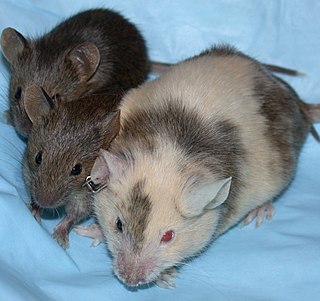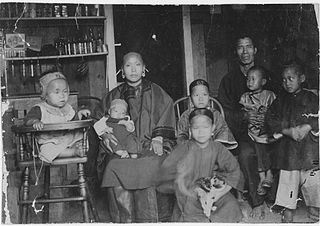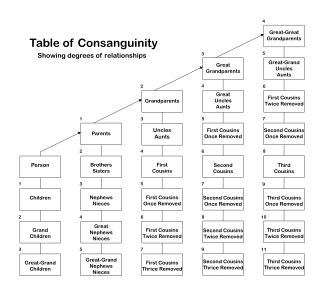
The nature versus nurture debate involves whether human behavior is determined by the environment, either prenatal or during a person's life, or by a person's genes. The alliterative expression "nature and nurture" in English has been in use since at least the Elizabethan period and goes back to medieval French.

Inbreeding is the production of offspring from the mating or breeding of individuals or organisms that are closely related genetically. By analogy, the term is used in human reproduction, but more commonly refers to the genetic disorders and other consequences that may arise from expression of deleterious or recessive traits resulting from incestuous sexual relationships and consanguinity.

Twins are two offspring produced by the same pregnancy. Twins can be either monozygotic ('identical'), meaning that they develop from one zygote, which splits and forms two embryos, or dizygotic ('fraternal'), meaning that each twin develops from a separate egg and each egg is fertilized by its own sperm cell.
A parent is a caregiver of the offspring in their own species. In humans, a parent is the caretaker of a child. A biological parent is a person whose gamete resulted in a child, a male through the sperm, and a female through the ovum. Biological parents are first-degree relatives and have 50% genetic meet. A female can also become a parent through surrogacy. Some parents may be adoptive parents, who nurture and raise an offspring, but are not biologically related to the child. Orphans without adoptive parents can be raised by their grandparents or other family members.

A genetic chimerism or chimera (/kaɪˈmɪərə/ ky-MEER-ə or /kɪˈmɪərə/ kə-MEER-ə, also chimaera is a single organism composed of cells with distinct genotypes. In animals, this means an individual derived from two or more zygotes, which can include possessing blood cells of different blood types, subtle variations in form and, if the zygotes were of differing sexes, then even the possession of both female and male sex organs. Animal chimeras are produced by the merger of multiple fertilized eggs. In plant chimeras, however, the distinct types of tissue may originate from the same zygote, and the difference is often due to mutation during ordinary cell division. Normally, genetic chimerism is not visible on casual inspection; however, it has been detected in the course of proving parentage.

Heritability is a statistic used in the fields of breeding and genetics that estimates the degree of variation in a phenotypic trait in a population that is due to genetic variation between individuals in that population. In other words, the concept of heritability can alternately be expressed in the form of the following question: "What is the proportion of the variation in a given trait within a population that is not explained by the environment or random chance?"
Twin studies are studies conducted on identical or fraternal twins. They aim to reveal the importance of environmental and genetic influences for traits, phenotypes, and disorders. Twin research is considered a key tool in behavioral genetics and in content fields, from biology to psychology. Twin studies are part of the broader methodology used in behavior genetics, which uses all data that are genetically informative – siblings studies, adoption studies, pedigree, etc. These studies have been used to track traits ranging from personal behavior to the presentation of severe mental illnesses such as schizophrenia.
A sibling is one of two or more individuals having one or both parents in common. A full sibling is a first-degree relative. A male sibling is a brother, and a female sibling is a sister. In most societies throughout the world, siblings often grow up together, thereby facilitating the development of strong emotional bonds. The emotional bond between siblings is often complicated and is influenced by factors such as parental treatment, birth order, personality, and personal experiences outside the family.

Cheek kissing is a ritual or social kissing gesture to indicate friendship, family relationship, perform a greeting, to confer congratulations, to comfort someone, to show respect.
The coefficient of relationship is a measure of the degree of consanguinity between two individuals. The term coefficient of relationship was defined by Sewall Wright in 1922, and was derived from his definition of the coefficient of inbreeding of 1921. The measure is most commonly used in genetics and genealogy. A coefficient of inbreeding can be calculated for an individual, and is typically one-half the coefficient of relationship between the parents.
Commonly, "cousin" refers to a "first cousin", people whose most recent common ancestor is a grandparent. A first cousin is a third-degree relative and used to be known as a cousin-german, though this term is rarely used today.

The Chinese kinship system is classified as a "Sudanese" or "descriptive" system for the definition of family. Identified by Lewis Henry Morgan in his 1871 work Systems of Consanguinity and Affinity of the Human Family, the Sudanese system is one of the six major kinship systems together with Eskimo, Hawaiian, Iroquois, Crow, and Omaha.

In the context of human society, a family is a group of people related either by consanguinity, affinity, or co-residence or some combination of these. The purpose of families is to maintain the well-being of its members and of society. Ideally, families would offer predictability, structure, and safety as members mature and participate in the community. In most societies, it is within families children acquire socialization for life outside the family. Additionally, as the basic unit for meeting the basic needs of its members, it provides a sense of boundaries for performing tasks in a heterosexual environment, ideally builds a person into a functional adult, transmits culture, and ensures continuity of humankind with precedents of knowledge.

Irving Isadore Gottesman was an American professor of psychology who devoted most of his career to the study of the genetics of schizophrenia. He wrote 17 books and more than 290 other publications, mostly on schizophrenia and behavioral genetics, and created the first academic program on behavioral genetics in the United States. He won awards such as the Hofheimer Prize for Research, the highest award from the American Psychiatric Association for psychiatric research. Lastly, Gottesman was a professor in the psychology department at the University of Minnesota, where he received his Ph.D.
Laws regarding incest vary considerably between jurisdictions, and depend on the type of sexual activity and the nature of the family relationship of the parties involved, as well as the age and sex of the parties. Besides legal prohibitions, at least some forms of incest are also socially taboo or frowned upon in most cultures around the world.

Zygosity is the degree of similarity of the alleles for a trait in an organism.
Uncle is a male family relationship or kinship within an extended or immediate family. Uncles are second-degree relatives and share 25% genetic overlap when they are the full brother of one of the biological parents. An uncle is the brother or a friend of a parent. A half-uncle is the half-brother of one's parent. "Uncle-in-law" can refer to the husband of one's aunt or uncle of one's spouse. A biological uncle is a second degree male relative and shares 25% genetic overlap. However people who are not a biological uncle are sometimes affectionately called as an uncle as a title of admiration and respect. The co-uncle-in-law is the husband of one's aunt of one's spouse.

Mano or pagmamano is an "honoring-gesture" used in Filipino culture performed as a sign of respect to elders and as a way of requesting a blessing from the elder. Similar to hand-kissing, the person giving the greeting bows towards the hand of the elder and presses their forehead on the elder's hand. Usually performed with the right hand, the person showing respect may ask "Mano po" to the elder in order to ask permission to initiate the gesture. Typically someone may mano to their older relatives upon entry into their home or upon seeing them.
Adoption studies are one of the classic tools of behavioral genetics. These studies are used to estimate the degree to which variation in a trait is due to environmental and genetic influences. Adoption studies are typically used together with twin studies when estimating heritability. There are two adoption study designs. The adoptee's method investigates similarities between the adoptee and their biological and adoptive parents. Similarity with the biological parent is expected to be heritable genetic effect, while similarity with the adoptive parent is associated with home-environment, called the shared environmental effect. The familial method compares non-biological siblings who are reared in the same household. Similarity to non-biological siblings raised in the same household is attributed to shared environment effect, as the siblings are biologically unrelated but share the home environment. The most powerful form of adoption studies compare pairs of genetically-identical monozygotic identical twins who are adopted into different families (MZA); however, historical changes in adoption practices to try to keep twin pairs together make these now the rarest kind of adoption studies. Variation that cannot be accounted by either genetics or home-environment is typically described as non-shared environment. Adoption studies are one of the key tools in behavioral genetics and are typically used in combination with twin studies when making habitability estimates.













